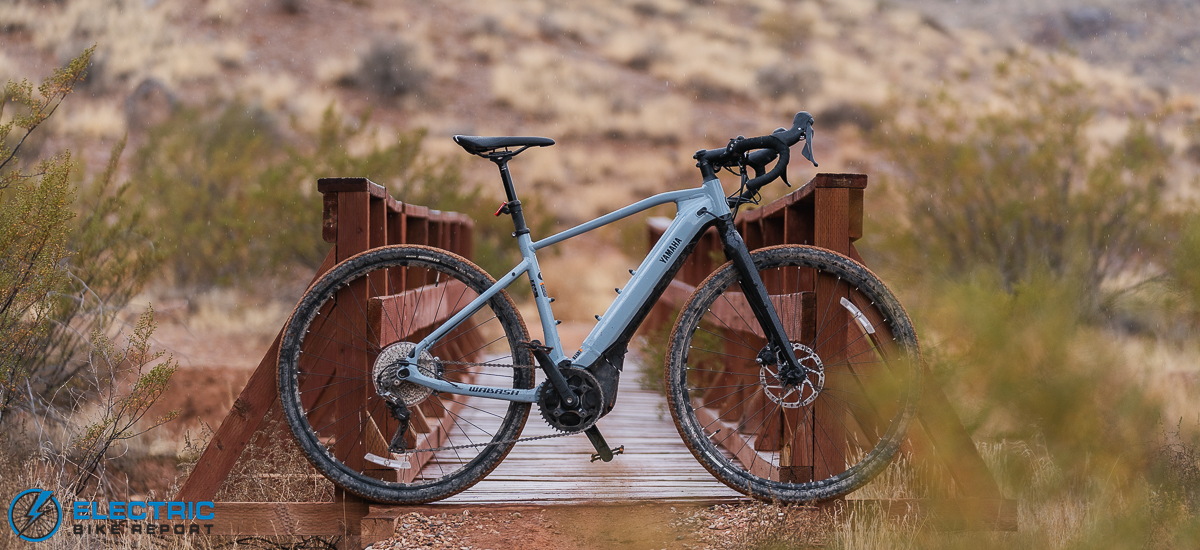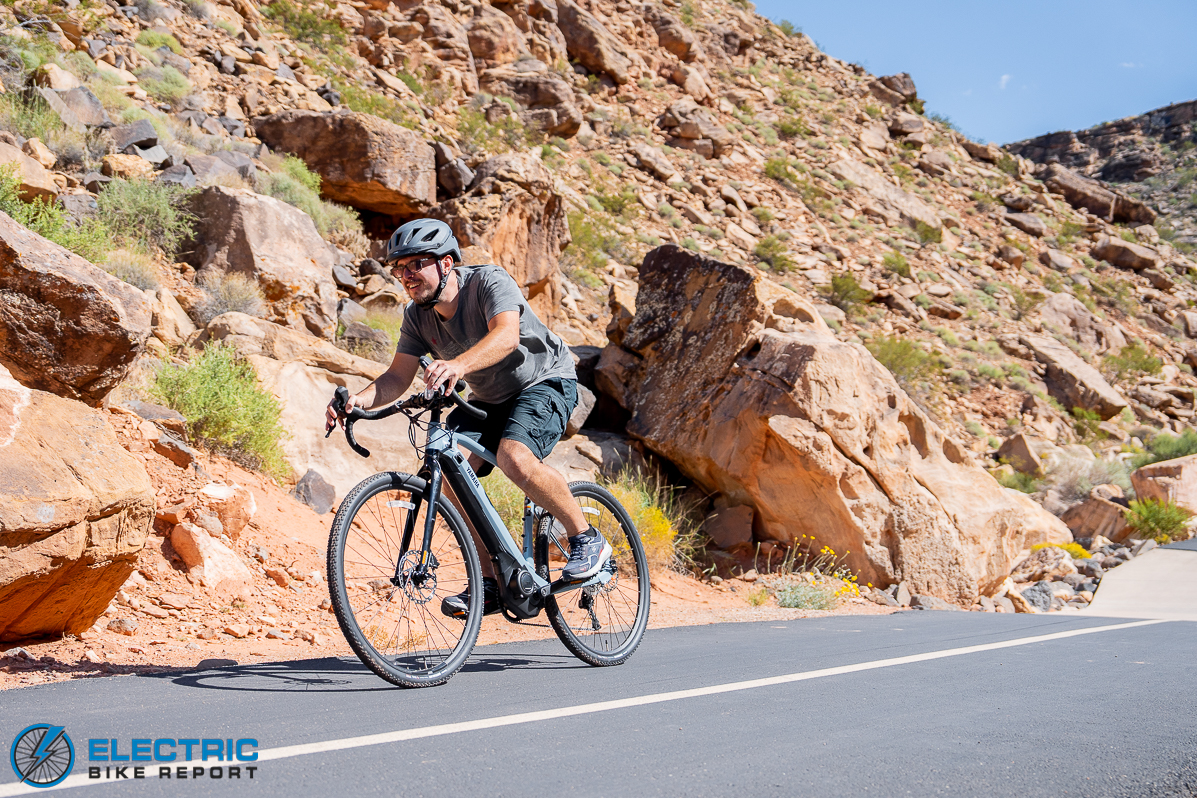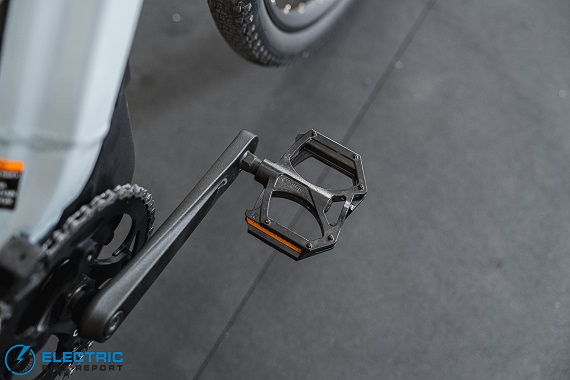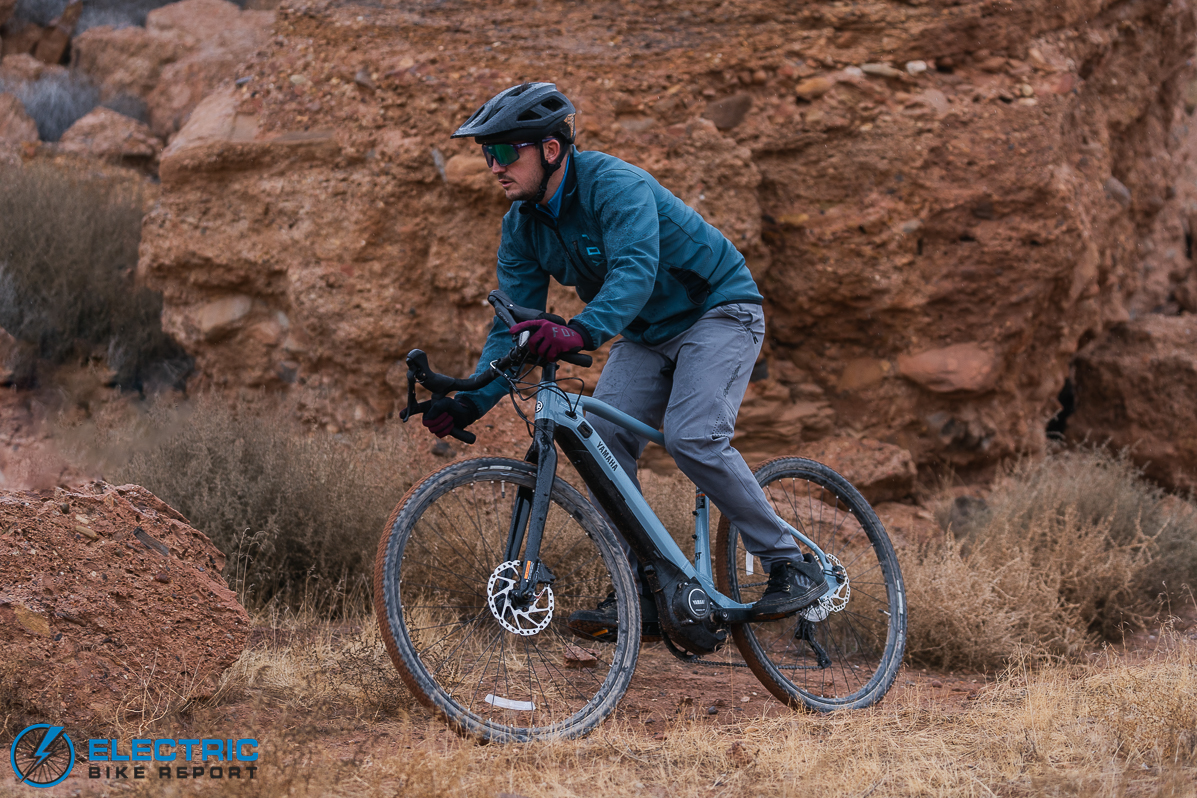Yamaha Wabash RT E-Bike Review, 2024
This powerful, well-crafted e-bike makes gravel riding accessible and fun!

At the center of the bike’s riding experience is its PW Series ST mid-drive motor. Also made by Yamaha, this 250-watt drive unit makes pedaling easy, but preserves the analog feel of a non-electric bike. With four types of sensors to inform its motor, we think dedicated cyclists will quickly get hooked on the bike’s traditional yet powerful feel.
The Wabash RT gains other benefits from its heritage; with 30 years of experience and separate divisions for motors and batteries, Yamaha clearly knows how to maximize the efficiency of its components. The pairing of the bike’s 250W mid-drive and 500 watt-hour (Wh) battery allowed us to ride for a frankly ridiculous number of miles before needing to refuel!
When riding on doubletrack, we appreciated the stability and control granted by its flared 44cm drop bars. The drops themselves, which measure 55cm center-to-center, helped us to steer precisely while providing easy access to the brake and shift levers.
These are just a few elements that stood out to us during our time on the bike. To see how it performed in our Speed, Brake, Range, and Hill Tests, check out our full Yamaha Wabash RT review below!
 Pros
Pros- An analog cycling experience at all power levels thanks to the remarkably natural-feeling 250W PW Series ST mid-drive motor with torque, speed, cadence, and slope sensors.
- Covers tons of miles or time between charges with an efficient motor and 36V, 500 Wh battery.
- Great steering control and stability from the wide 44cm flared drop bars.
- The bike felt planted yet agile, with its grippy 700c x 45 mm tires and 48-lb total weight.
- An easy, seamless Auto Assist setting responds intuitively to give more power when pedaling harder.
- Responsive shifting, a flexible gearing range, and solid stopping power from the Shimano GRX groupset.
- Easily keeps up with traffic due to its Class 3 speeds of up to 28 mph.
- Ride with less concern for flats after converting the tubeless-ready rims and Maxxis Rambler tires.
- Trust your purchase with a 3-year warranty that covers the motor, battery, and frame.
 Cons
Cons- We liked the included dropper/suspension seatpost but found its lever position on the handlebar awkward to use. We’d prefer Shimano’s combination brake and dropper post lever.
- It may seem nitpicky, but we hope to see improved cable management in the future to prevent paint wear on the head tube.
- Battery: Yamaha Lithium Ion 500Wh, 36V, 13.4Ah
- Display: Black and White display
- Motor: Yamaha PWSeries ST 250W Nominal, 500W Max, 70Nm Torque
- Headlight:N/A
- Taillights:N/A
- Pedal Assist: Eco+, Eco, Standard, High w/ 4-
- Throttle: N/A
- UL Certification:UL 2849 Certified
- Claimed weight: 48 lbs (actual weight)
- Rider height range: 5’-1” to 5’-7” (S), 5’-5” to 6’-0” (M), 5’-7” to 6’-7” (L)
- Total payload capacity: 275 lbs
- Brakes:Shimano GRX RX600-rear, RX400-front, 180mm Centerlock
- Fenders:Not included
- Fork:One-Piece Aluminum. 12x100mm Thru-Axle. Fender and rack compatible. Internal brake hose routing
- Frame: Yamaha Hydroformed Aluminum. Integrated battery. Water bottle boss. Internal shift/brake hose routing
- Drivetrain: Shimano GRX, 44T chainring, 11-speed 11-42T cassette
- Grips: Padded cork tape
- Saddle: Yamaha Off-Road Cro-Mo Rail
- Seatpost: 30.9 diam. Limotec Suspension Dropper Post, 40mm travel (S), 60mm travel (M,L)
- Handlebar: Flare drop, 31.8mm diameter, 44cm width
- Kickstand: Not included
- Pedals: Flat Pedals Included
- Tires: Maxxis Rambler 700 x 45c TR EXO 120tpi

With 700c x 45mm Maxxis Rambler tires and flared 440mm drop bars gave the Wabash RT great traction, handling, and control in its intended environment.

The 250W PW Series ST mid-drive motor has a peak of 500W with 70 Nm of torque.

The 36V, 500Wh battery is concealed in the down tube and charges in about 4 hours.
Yamaha Wabash RT Review: Speed Test
The course for our Speed Test is a flat portion of our local network of shared use paths. We pedaled the Wabash RT in each of its four standard pedal assist system (PAS) settings with a consistent level of effort to observe the resulting differences in speed. We also rode it with no pedal assistance to establish a baseline for the trial.
When pedaling without the motor, we were able to reach 14.1 mph, which in most cases is no easy feat on an e-bike. The Wabash’s 48-lb frame is on the lighter side and thus easier to pedal, while its aggressive forward-leaning riding position helps to grant it additional speed by increasing aerodynamics.
With the PAS engaged in its lowest setting, Eco+, the motor gave us an additional mile per hour in our maximum speed up to 15.1 mph. The second setting, Eco, felt much more impactful and carried us to 18.5 mph. Standard (the third PAS mode) gave us 20.3 mph, while High (the max assist setting), shot up to 25.2 mph.
With these data points graphed out (see the graphic above), we can see a visual representation of our experience on the bike; the difference made by Eco+ was minimal, while the jumps to Eco and Standard were relatively even, and the final assist level in High ramped up the motor’s power level noticeably.

Riding fast and low is especially rewarding in the Wabash RT’s Auto Assist mode.

One component of the Shimano GRX groupset is the 11-42T cassette with broad flexibility for flats, hills, asphalt, or gravel.

The bike includes flat pedals that can easily be swapped for a clipless setup.
The speed and power distribution of the Wabash RT’s PAS settings is decent; with a 48V electrical system and access to Class 3 speeds of up to 28 mph, the bike is able to quickly draw power to accelerate and both reach and maintain a high velocity.
We would prefer to see an increase in the power of Eco+, as the bike did not feel notably different from our first stage with no assist. Otherwise, the PAS settings provided relatively expected and meaningful differences in power, allowing riders to find their desired balance between speed and efficiency.
When riding on relatively hilly gravel and dirt doubletrack, we found all settings above Eco+ to be practical. The bike’s Auto Assist mode was particularly enjoyable (more on that later), but none of the settings felt over or underpowered; they simply offered a range of pedal intensity from moderate to breezy.
Yamaha Wabash RT Review: Range Test
Explained in the graphic above, our Range Tests allowed us to evaluate the life of the Wabash RT’s 36V, 500 Wh battery and the efficiency of its 250W motor – both made by Yamaha.
The brand does not advertise a range for the Wabash, but when riding the bike in High and Eco (we think most riders will choose this over Eco+) modes, we traveled 43.8 and 125.7 miles respectively. The duration of our tests ranged from 2 hours and 47 minutes to 10 hours and 31 minutes.
At the time of writing, this is currently the greatest distance we have traveled on any of the hundreds of e-bikes we have tested! Simply put, the Wabash RT greatly exceeded our expectations. Furthermore, considering that we measured nearly 2,500 feet of elevation gain during our testing, we believe that it is possible for those riding on flat terrain to cover even more ground on paved surfaces. Those using Eco+ may be able to go even longer.
With that in mind, true gravel riding on doubletrack or singletrack should result in less distance, as motor/battery efficiency goes down on rough, loose, and hilly terrain.
To illustrate the Wabah RT’s efficiency, we used its nominal motor wattage and battery capacity in watt-hours to estimate the time for our Range Test in High mode. Based on these figures (a 250W motor and 500 Wh battery), we anticipated that our range test would take 2 hours, but our real-world test results showed a 39% increase in time.
To be fair, we pedaled at a fairly casual pace (an average speed of 15.8 miles per hour), which helped to extend our time, but the simple fact that the Wabash RT uses a mid-drive grants it an advantage. This type of motor naturally leverages the rider’s effort and allows for a variable amount of output, thereby reducing the draw on the battery.
Overall, we were floored by the Wabash RT’s performance, as it offers a massive and highly functional amount of range for both of the bike’s intended environments. Riders seeking a traditional cycling experience with low power can coax a huge number of miles from the battery, while those who prefer a more leisurely ride can still benefit from the motor/battery efficiency and cover a lot of ground.
Yamaha Wabash RT Review: Hill Test
This is one of the best times we have observed from any of the e-bikes we have tested with 250W mid-drive motors. Peak motor wattage and torque are two major contributing factors to an e-bike’s performance in this test. The Wabash RT’s motor has a peak of 500 watts and a maximum torque output of 70 Newton-meters (Nm), which is relatively middle-of-the-road in terms of output. This interpretation is supported by our data, as one of the few similarly-specced e-bikes that outpaced the Wabash had a max of 90 Nm of torque.
These figures are not the only contributing factors to the bike’s performance, however, as evidenced by the performance of Yamaha’s CrossCore RC. The Wabash and CrossCore share the same motor and battery, but the Wabash climbed Hell Hole Trail 7 seconds faster with a 0.9 mph increase in speed.
We attribute this largely to the Wabash RT’s more aggressive and aerodynamic riding position and overall lower weight (48 lbs vs 53 lbs). With an 11-speed drivetrain and 11-42T cassette, it also has a wider gearing range that is better-suited for climbing.
Naturally, pedaling up any hill on an e-bike with a mid-drive motor requires some effort, since the motor is dividing the work required with the rider. With that in mind, the Wabash RT proved to have enough power to make the task simple, comfortable, and enjoyable. There are few hills likely to be intimidating when riding the Wabash RT, and we were highly pleased with its performance.

With its PW Series ST mid-drive, the Wabash RT feels powerful, giving a responsive, fun, and easy ride.

The right brake lever includes shift levers for quick and comfortable gear changes.

The Shimano GRX hydraulic disc brakes proved highly effective in our testing.
Yamaha Wabash RT Review: Brake Test

The Wabash RT is equipped with a full Shimano GRX groupset, including its combination shifter/brake levers, drivetrain, and hydraulic disc brake system. This includes two-piston brake calipers with a 160mm rotor on the rear wheel and a 180mm rotor up front.
We evaluated this brake system using the process described above, then calculated an average stopping distance of 20 feet, 8 inches using the three individual measurements we recorded. This is an excellent result overall – our average for all of the e-bikes we have tested is currently 23 feet, 5 inches – which indicates that the GRX brake system is safe and extremely effective.
When testing the bike on dirt and gravel doubletrack, we found that their real-world performance reinforced our test results. We felt instantaneous response with solid bite from the calipers, which allowed us to quickly adjust speed when approaching rocky, washed out areas of trail.
In summary, the Wabash RT is specced well with a great brake system that performs extremely well on both paved and unpaved surfaces.

The flared 44cm drop bars provided great stability and control.

We found the saddle to be supportive, if a little on the firm side.

The handlebars were comfortable, but we’d like to see Shimano’s combo brake/dropper post lever on the left side.

The 700c x 45mm Maxxis Rambler tires chewed through loose terrain with ease.
Yamaha Wabash RT Review: Ride Quality
Yamaha intends for the bike to be used by both road and gravel cyclists, though we found that it leaned more heavily into gravel with its handlebars, tires, suspension/dropper seatpost, and overall geometry.
In truth, when compared to similar gravel e-bikes from other well-established, popular brands, the Wabash RT’s geometry is a bit more relaxed. It comes in three frame sizes (S, M, and L) with reach ranging from 368mm to 402mm and stack from 595mm to 617mm, so its forward-leaning riding position is somewhat less aggressive and more upright than much of its competition. With a wheelbase ranging from 1057mm to 1090mm, it’s also a little on the longer side.
While less suited to racing, we found its positioning to be comfortable for long periods of time, and perhaps more friendly to commuters who plan to take advantage of the option to equip the bike with fenders and a cargo rack. Its longer wheelbase helped the bike to feel stable and planted at high speeds, while not so long that it negatively affected handling.
Its overall handling was quick, light, and responsive, but its weight prevented it from feeling too airy. When using the flared drops on the handlebar, we found cornering especially sharp and precise. The 700c x 45mm Maxxis Rambler tires did a fantastic job of gripping and remaining stable when carving through loose dirt.
The Wabash RT comes with tubeless-ready rims and tires, making it possible with a few steps to convert to a system less prone to flats. We recommend going tubeless, as the 120tpi EXO version of the Rambler tires, which are lighter and less durable, provided little protection when using tubes (at least in our local desert environment where sharp things are plentiful).
We greatly appreciated the fact that the Wabash included 45mm tires for added comfort and stability. The tires can be aired down to make the ride softer (and provide better grip) since there is no front suspension. The bike does, however, include a dropper seatpost with 40 or 60mm of travel depending on frame size, which also includes 25mm of suspension to smooth out any bumps.

While a color display would be nice, the current setup is easy to read and operate.

We greatly appreciated the 25mm suspension in the dropper seatpost.

Bosses on the fork, down, tube, and stem allow riders to carry gear on longer adventures.

The attachment points for the optional cargo rack are hidden above the optional fender mounts.
The Wabash RT also has an Auto Assist mode (I promised we’d return to this) that we loved. Once engaged (by holding the up arrow for 1 second), riders can pedal naturally while the PAS adjusts smoothly to compensate for changes in pedaling. This was similar to the way that a torque sensor works, but made even simpler; pedaling with little pressure uses Eco mode, while pedaling hard kicks the power level up to High.
In terms of contact points, we found the bike’s saddle to be on the firm side, though we liked the flared 44cm handlebars wrapped with padded cork tape. With the center-to-center measurement at the top of the brake levers being 38cm, there is a serious sweep to the drops that provides stability, control, and easy access to the brakes. The Wabash comes with flat pedals on 165 or 170mm cranks (depending on frame size), but of course those can be swapped to clipless pedals if desired.
The Wabash RT’s cockpit was simple, with a black-and-white display (we hoped to see a color display considering the Wabash RT’s price), a bell, and a dropper post lever in addition to the brake/shift levers. The dropper post lever’s placement on the top felt awkward to use on the fly, so we’d prefer to see Yamaha switch the left brake lever to the Shimano ST-RX810-LA which includes a control for a dropper post.
We also found that the bike’s cable management could be improved; our test bike shipped with a brake cable too close to the head tube which caused wear to the paint during our testing.
We liked how well the Wabash was suited for bikepacking adventures; there are mounting bosses on the seat tube, down tube, and fork. The wide handlebars also offer ample space for a gear bag up front – plus, as mentioned above, Yamaha offers a compatible cargo rack with a 55-lb capacity.
Ultimately, while there are a few minor areas with room for improvement, we found ourselves thoroughly impressed with the Wabash RT and its fantastic ride feel!
Yamaha Wabash RT Review: Summary / Where to Buy
The Wabash RT showed great performance in every facet of our testing and review process. We were most impressed by its staggering range potential of well over 100 miles. The bike’s ride feel and the efficiency of its motor and battery prove that Yamaha has applied their decades of experience effectively to create a widely appealing road/gravel bike.
We found only a few minor areas of critique, with the most relevant being the paint wear on the head tube from less-than-ideal cable management, and the placement of the dropper post lever. We think these concerns would be easily remedied with minimal cost, so we hope that Yamaha addresses them on the next iteration of the bike.
Otherwise, we happily recommend the Wabash RT for cyclists seeking a fun, comfortable, and easy to use road/gravel e-bike that still feels like a bike!
Happy Riding! Make sure to let us know if you have any questions or if you think we left anything out in this review of the Yamaha Wabash RT down in our comments section.



